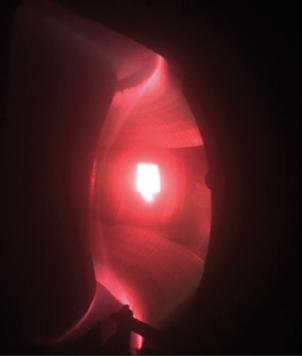Known as a liquid lithium limiter, it circulates the molten metal around the tokamak walls, assisting fusion by preventing the plasma from cooling down. The device, described in the journal Nuclear Fusion, has been tested at the Experimental Advanced Superconducting Tokamak (EAST) in Hefei, China.

"We demonstrated a continuous, recirculating lithium flow for several hours in a tokamak," said Rajesh Maingi, head of boundary physics research and plasma-facing components at PPPL.
"We also demonstrated that the flowing liquid lithium surface was compatible with high plasma confinement and with reduced recycling of the hydrogen isotope deuterium to an extent previously achieved only with evaporated lithium coatings. The recirculating lithium provides a fresh, clean surface that can be used for long-lasting plasma discharges."
The limiter uses an electromagnetic pump that circulates the lithium from a distributor to the top of an angled guide plate inside the EAST tokamak. This pump works with the magnetic field within EAST to drive the lithium to the top of the plate during plasma discharges. The lithium then flows down the front surface of the plate and serves as the main point of contact between the plasma and the plasma-facing components of the EAST vessel.
Serving as the main point of contact with plasma enables the lithium to absorb the hot deuterium ions that drift from the centre of the plasma, and keeps them from striking the interior walls of the tokamak and cooling down. Limiting the amount of cool deuterium at the edge of the plasma reduces the difference in temperature between the hot plasma centre and the cooler edge, and reduces turbulence.
The PPPL team found that contact with the ions caused some damage to the limiter’s thin stainless steel foil surface, and the next step of the research will be to address this issue.




Glasgow trial explores AR cues for autonomous road safety
They've ploughed into a few vulnerable road users in the past. Making that less likely will make it spectacularly easy to stop the traffic for...